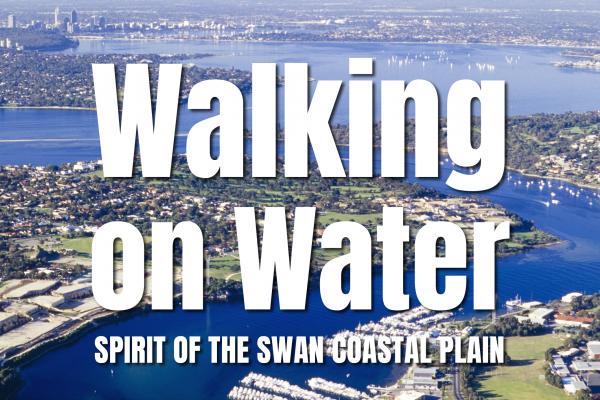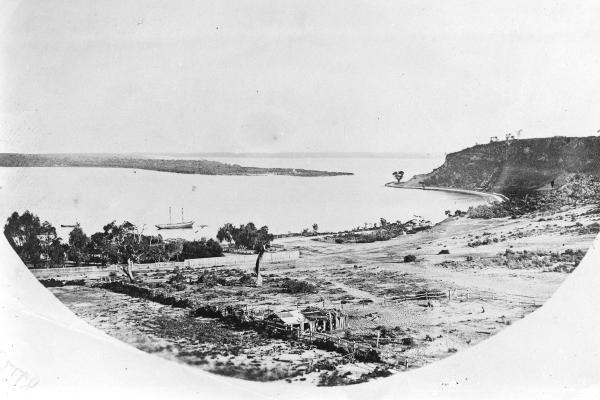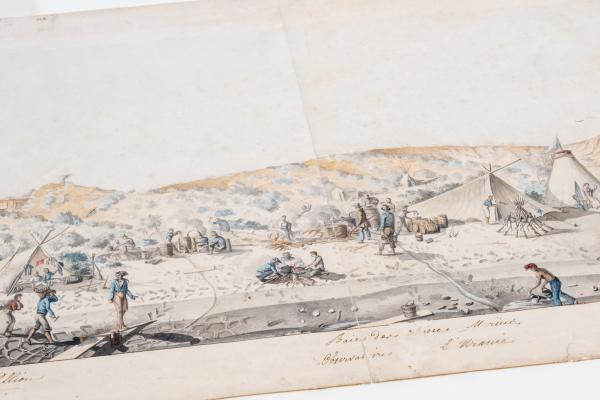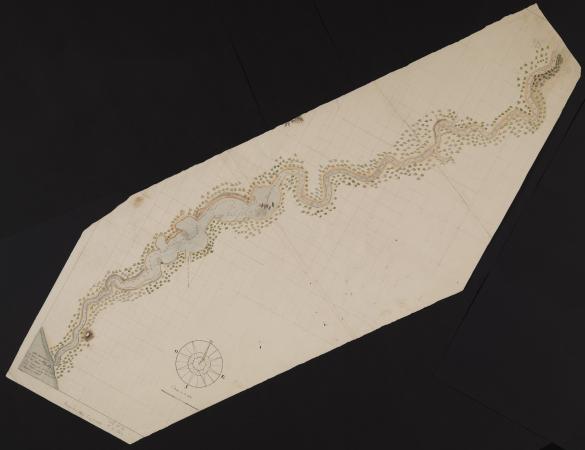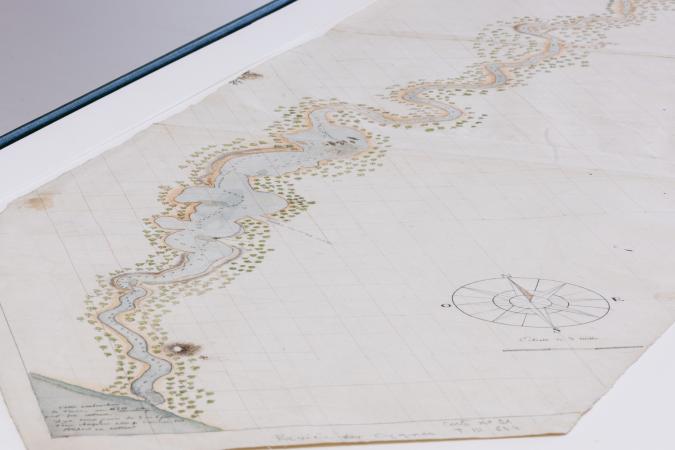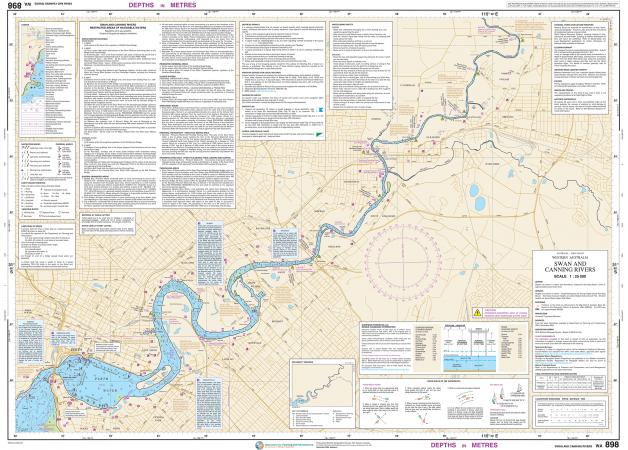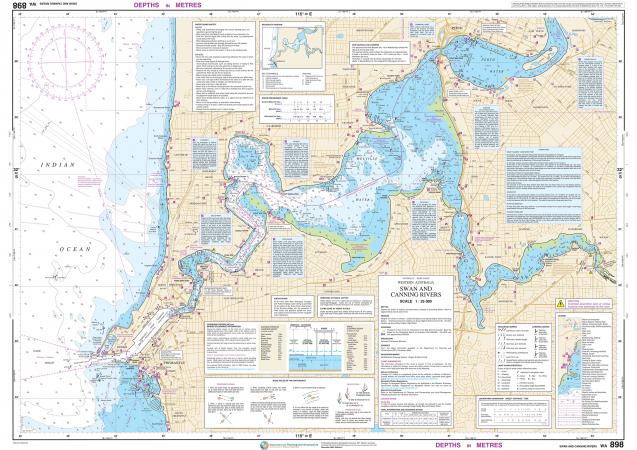Join Dr Kate on ABC Radio as she shares the behind-the-scenes view into making the State Library’s podcast series ‘Rare Stories from the West’, with producer Gina Pickering from Latitude Creative Services.
The first episode, ‘Walking on Water: Spirit of the Swan Coastal Plain’, explores the significance of the Derbarl Yerrigan (Swan River) in creating the city of Perth. Aboriginal elders Noel Nannup and Marie Taylor explain the Aboriginal history of the river through the Waugal creation story on Whadjuk Noongar Boodjar (now metropolitan Perth). Charted by French maritime exploration voyages in the early 1800s, the State Library preserves many archival documents about the Swan River. This podcast shares Noongar culture and knowledge, plus contemporary poetry that draws on the river as a source of inspiration by Dr Nandi Chinna, Jennifer Kornberger and Daniel Hansen.
Recorded on 19 November 2021.
Transcript
BEGINNING OF INTERVIEW
Christine: So this afternoon on History Repeated: Rivers - they shake communities, they’re often at the heart of where you live, go to play, but what about the stories behind them?
The State Library of WA has released a podcast called ‘Walking on Water – Spirit of the Swan Coastal Plain’. It explores the significance of Derbarl Yerrigan (Swan River) in the creation of the City of Perth and it’s the first series of podcasts exploring rare stories from the West, so in the studios I have Dr Kate Gregory, Battye Historian from the State Library.
Hello Kate!
Dr Gregory: Hi Christine.
Christine: And I have Gina Pickering from Latitude Creative Services who crafted these podcasts.
Hello Gina!
Gina: Hi Christine. So nice to be here.
Christine: Thank you for coming in. Let’s get into this Kate. Let’s turn to the archives first. What kind of material does the State Library have about this one?
Dr Gregory: Well, you can probably imagine. We’ve got a huge collection of material about the Swan River and the Swan River Colony particularly and we’ve got one very, very special treasure in particular which is part of the Freycinet collection which we have talked about before.
Christine: Yes, Freycinet remember. Yes...
Dr Gregory: Yes, so this is part of the collection that relates to the French maritime exploration of the WA coast and Western Australia and the French as we know were very much driven from a scientific perspective. They were really at this time...so this is around 1800. Around this time, they were really going out into the world and they came to Australia to gain as much knowledge as possible about the geography, the geology, the natural environment and so they collected specimens, they recorded, they made maps and charts and recorded as much as they could and it was a very scientific approach and I mean we are very lucky at the State Library to have this incredible collection of Freycinet material which includes this map which is the first chart that we know of, of the Swan River.
Christine: Wow, so...
Dr Gregory: So, it’s an absolute treasure and the chart itself; it’s quite large if you can imagine, it’s probably about a metre long. That’s quite large and it’s in pencil, coloured pencil, a bit of ink as well and it just… it is literally a kind of chart of the topography of the contours of the river and it also includes the soundings, the depth of the river, so they were taking soundings as they went along and this little... so this is a long boat that set out from Baudin’s... so this is part of Baudin’s voyage in 1801 and Heirisson. So we know Heirisson Island named after Heirisson who was actually the artist of this chart of the Swan River so they set out in a long boat and it took them... I think they probably took this expedition up the Swan River; I think over the course of about six days and it was quite hard. It was in June. It was wet and cold and muddy and... but anyway they created this incredible chart and it is the first known chart of the Swan River. So, it’s a huge treasure within the collection but what it misses out on is the spiritual and the social and the Aboriginal significance of the river. So, I guess what we were looking at is, we’ve got these wonderful collections, these really important treasures, but how can we bring them into contemporary conversations now about the importance of the river and particularly the Aboriginal significance because that is one thing that is sorely lacking within our collections and I think that as a cultural institution in some ways we are attempting now to kind of catch up with that. To have these conversations with Aboriginal communities around their own history, their own stories, their own culture and working with communities to make sure that that perspective is heard.
Christine: And that’s why you’ve got this podcast.
Dr Gregory: That’s why. So that’s the impetus for the podcast. It was kind of sparked by the collections and really wanting to bring it in to a contemporary conversation.
Christine: Yes, wonderful. This is Dr Kate Gregory speaking. Battye Historian and I’ve got Gina Pickering, Consultant at Latitude Creative Services. The podcast we’re talking about is called ‘Walking on Water – Spirit of the Swan Coastal Plain’. The State Library website is where you need to go.
So, what is the State Library hoping to achieve through this podcast, Gina tell me.
Gina: Well, I think a few things. Look it’s just been a wonderful opportunity to be able to put something like this together particularly. I suppose, over the last 10 years or so I’ve been looking at the cultural values and involved in the cultural values of the river from all the perspectives that are linked to it and yes it’s a learning along the way and you learn, you learn, you learn, you learn and I think there’s much emphasis these days toward aiming to a shared vision for our river between the Wadjuk Noongar and the settler community here and so when I look at what’s available in the collection, there’s a few things that go on. There’s well what’s driven that collection and Kate can probably talk to you another time about the history of collecting and more...
Christine: Yes, let’s focus on the podcasts because there’s stories within it that transform the concept of the Swan River Plain. Can you tell me about those?
Gina: Well look, I suppose what I’ve tried to do is pull together some really special voices. I think hearing others who can articulate themselves very well can be helpful for us to articulate what we think. We may not always have the words. I think the people who are in this particularly Noel Nannup, particularly Marie Taylor, Sue Broomhall. The poets, they bring a different way of articulating river, and it is a very complex thing. It’s a physical resource but it’s a spiritual place and I think everyone is still learning about that and we’re still learning about where we are here, including me.
Christine: Shall we hear one of the voices from the podcast. Have a listen everyone.
“The significance of the river here in Noongar country is that it was part of the creation story of the Wagyl, the rainbow serpent. When he left borage and rock and he came down through York, Northam and back down through Midland, wherever he turned, he created the hole for the river. And then the water came and filled the river up”.
Christine: So tell me, who are we hearing and what are they talking about?
Gina: Ok, so...that’s Marie Taylor. Fabulous woman, incredible leader. She’s a Whadjuck Noongar elder. Marie has very generously walked with me through a number of big projects including the interpretation for the rivers which was a project back in 2013, 2014 which brought a lot of things together and brought a lot of Noongar people together. The... I think as we’re going forward now, quickly you can see that there is a huge momentum towards bringing our cultures together through Danjoo Koorliny, through the pilot projects that are at the universities. For example, reconnecting to rivers which is focusing on one area at Curtin University at Blackadder Creek. UWA - there’s a big search to pull in all the Whadjuck Noongar water knowledge. So these momentums and the flow of them is increasing. I think the thing too, is people are just starting to understand a relational context between everything that’s in our environment and how it impacts with us and how we impact with it.
Christine: So, what is the significance of sharing these stories Gina?
Gina: We live in a place that has the oldest culture in the world. We’re heading towards a bi-centenary. I think for everyone who lives here, there will be questions personally and from a community level about what we’ve managed to do and what we haven’t managed to do and what sort of legacies have been left behind.
Can I say also that the ABC has contributed hugely to this. Certainly, in a lot of the work I’ve done, I’ve audited all the news stories... all the TV news stories, right from 1960 right up to the 2000s and you can see the changes in the focuses of the news. So you’ve got the journalists, you’ve got the community, you’ve got the chiefs of staff who’ve got... oh no, this is important. One of the first stories in the first four days was on the conservation of the Swan River.
Christine: Wow, and with your journalistic background, it’s great that you were able to find that. Look, the Swan is a playground for so many people, but the podcast also explores how the river has been connected to darker stories. Can you tell us about that Gina?
Gina: Well I think people use the river for so many reasons. Some people are very connected to it. Perhaps they’ve put the ashes of their parents in it. There have been suicides in the river. There are murders, there are bodies that have been washed up. It has a darker side. There is that above and below. I think also, it stores a lot of memories for people and those memories can be both positive and also very challenging or very sad. So, the emotional capacity of the river is enormous and a lot of research was done in 2012... Professor Sue Broomhall and myself worked on that and with the National Trust at the time which was a fantastic thing to look at our emotional connections. And one of the things that came out in that which was beautiful was just it didn’t matter who you were, or how old you were or what culture you were from, the emotional connection to somewhere on the river that meant something to you, didn’t ever clash through any kind of cultural issue. It was your own personal connection.
Christine: There’s some beautiful poetry in this podcast. Shall we have a listen?
“It unsettles me as I stare into its darkness. But I try not to turn away. I keep looking as long as it flows, parting from itself and meeting itself again in a quiet cove where it will rake the beach, shells are lifting and settling like breath and if I’m lucky enough to see black swans moving in pairs, returning home, I wonder if a river could break, I wonder if it is a snake or a turtle or if it is a god”.
Christine: Who are we hearing there?
Gina: Dr Nandi Chinna, fabulous poet from Western Australia and living in Fremantle at the moment. A poet in residence I think at City of Melville as we speak. Yes, she has a beautiful way of taking us in and you know the river is a gateway to understanding and Nandi takes us there in a gentler way that touches really deeply, I think.
Christine: Yeah, wonderful. Well Kate, what do you think about all this? How significant is the ongoing spiritual and social significance of the river for communities and for our records as well?
Dr Gregory: Hi, well I think, as Gina has so wonderfully described it has got huge significance and I think for me one of the biggest shifts in perception for me in listening to this podcast, is the awareness of rather than thinking about the Swan River, as a river, as a discrete body of water... to think about the Swan coastal plain and the network of sort of tributaries and the aquifer of water that is underneath Perth city as this reservoir of water and I... that sort of lives and breathes and swells with rain and depletes over summer and feeds on the tributaries and flows into the river and its beautifully, absolutely beautifully described by Noel Nannup in this podcast. And that’s a real shift in perception for me because we’ve kind of... I think the history of planning in Perth has been one of kind of shoring up the edges of the river if you like. We’re kind of... we’ve filled in lakes and swamp land. I mean the Perth Cultural Centre and the train station, we’ve built...
Christine: East Perth
Dr Gregory: Yes, that’s right. Plenty of infill and...
Christine: The Library.
Dr Gregory: The Library! Sits on this former lake. I think just that shift in perception about this actually being... and its counter to what we imagine but it actually being the importance of water in this landscape and this being a watery landscape. Yet that contrast with the dryness... it’s just, it’s just... yes. I think really, really...
Gina: Everyone thinks it’s really dry here but it’s just like... “What do you mean Daniel? You mean it’s not really dry?... Oh no, no it’s very wet”.
Dr Gregory: [Laughs] This podcast will challenge perceptions.
Christine: Yes, it has a bit of everything.
Well look, it was nice to hear about it. Thank you both for coming in on a Friday afternoon. Gina Pickering, very nice to meet you.
Gina: And you.
Christine: Dr Kate Gregory, I’ll see you again soon.
Dr Gregory: Yes, love to. Thanks Christine.
Christine: Battye Historian from the State Library.
So, it is called ‘Walking on Water, Spirit of the Swan Coastal Plains’.
So, if you go to the State Library of WA’s website or on Spotify you’ll find it.
END OF INTERVIEW
You might be interested in
